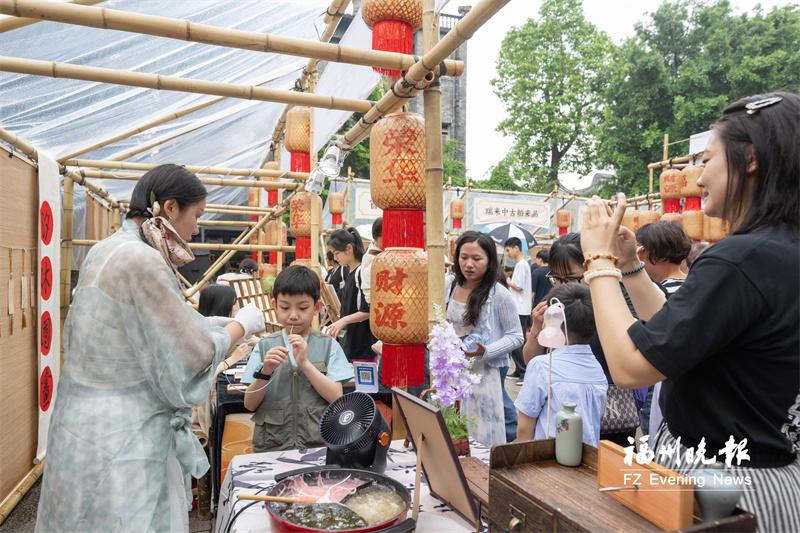Fuzhou’s Historical and Cultural Districts Packed with Visitors During May Day Holiday

The “Culture of the Song Dynasty: Tiangong Kaiwu Exhibition” at Sanfang Qixiang attracted a steady stream of locals and visitors.
Where was the hottest destination in Fuzhou on the first day of the May Day holiday? It had to be the historical and cultural districts such as Sanfang Qixiang and Shangxiahang, where the essence of Fuzhou’s rich cultural heritage draws crowds of visitors and fuels vibrant cultural tourism and spending.
“Look! The top scholar is here!” “The bronze statues have come to life!”… On May 1, vibrant performances and flash mobs energized Sanfang Qixiang. From the main area of Nanhou Street to Guanglu Yintai, the Waterside Stage, and the China-Chic Market, animated bronze installations, recreated Song-Dynasty street scenes, original theatrical productions, immersive shows, and pop-up performances brought the historical district vividly to life, offering visitors a dynamic cultural experience.
The bronze statues scattered along the main area of Nanhou Street are a signature feature of the “Lifang living fossils” of Sanfang Qixiang. During the May Day holiday, these statues were brought to life as dynamic showcases of Fuzhou’s intangible cultural heritage. Four themed installations—lantern-making, woodblock printing, bookbinding, and traditional Chinese medicine—were set up in the area, each showcasing core elements of Fuzhou’s intangible cultural heritage.
Over the May Day holiday, Sanfang Qixiang Historical and Cultural District embraced the vitality of spring, blending its ancient alleyway setting with intangible cultural heritage elements and modern festive themes. With poetic signage, artistic installations, and immersive lighting effects, the district created a rich, engaging experience that invited visitors to fully participate.
Beyond Sanfang Qixiang, Fuzhou’s other historical and cultural districts also buzzed with festive energy during the May Day holiday. In Shangxiahang, the interactive parade “A Century of Prosperity in Shangxiahang” attracted a large crowd of locals and tourists alike. The catchy Fuzhou children’s folk song Yue Guang Guang inspired a lively, graceful dance that featured traditional elements such as the “Three Hairpins” hairstyle and the jasmine tea scenting process, beautifully blending the historic charm of Xiahang Road with the youthful vibe of Longping Road.
Nowadays, more and more ancient buildings in the historical and cultural districts are being repurposed as art galleries, exhibition halls, and cultural venues, attracting an increasing number of young visitors.
In the Sanfang Qixiang Historical and Cultural District, the Former Residence of Wang Qi is showcasing the exhibition “Imperial Palace Treasures: Gan Guobao’s Taiwan Garrison Archives.” At No. 3 Nanhou Street, the Fujian Strait Folk Art Museum is hosting two exhibitions: “Ceramic Fire and Dreamscapes—Contemporary Wood-Fired Pottery Aesthetics” and “Mountain and Sea Carvings · Ink-Dyed Countryside—Peasant Woodcut Prints.” Meanwhile, the Cross-Strait Chinese Crested Tern Photography Exhibition, held at No. 51 Huangxiang in the Fuzhou Taiwan Guild Hall, has drawn considerable visitor interest.
In the Shangxiahang Historical and Cultural District, the contemporary art exhibition “Reconstruction of Port Memories” is being held across two key areas: the mountaintop and the old streets and alleys. At the Jianjun Guild Hall and the He Clan Ancestral Hall, visitors can explore two exhibitions—the female-focused “Three Hairpins and the Heritage of Mountains and Seas” and the specimen display “Egrets’ Haven · A Thousand Years of the Minjiang River.” Meanwhile, the Shangxiahang · Guihu Art Museum is hosting an ongoing art exhibition at No. 91 Shanghang Road. (Fuzhou Evening News Reporter: Guan Shu/Text; Lin Shuangwei/Photo)